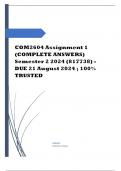ADMIN
[COMPANY NAME]
,QUESTION 1 STUDY UNIT 3 Approaches to the study of mass
communication When we attempt to describe, interpret, evaluate
and predict a phenomenon, in this case mass communication,
understanding said phenomenon is key. Various factors influence
this. 1.1 In a short paragraph, present a well-formulated definition
of mass communication using your own examples to substantiate
your answer. (5) 1.2 Further to the above, there are various
perspectives on mass communication. Briefly mention each of
these and their specific emphasis. (5) 1.3 The theoretical approach
you use also holds certain implications for your understanding of
mass communication. Briefly discuss the main characteristics of
the two approaches listed below: 1.3.1 The technological
determinism approach. (5) 1.3.2 The poststructionalist/postmodern
approach. (5) [TOTAL 20]
1.1 Definition of Mass Communication
Definition: Mass communication is the process by which a
person, group of people, or large organization creates a message
and transmits it through some type of medium to a large,
anonymous, heterogeneous audience. This process often involves
the use of technology to reach vast numbers of people
simultaneously.
Example: Consider a live broadcast of the FIFA World Cup final.
The game is transmitted via television and online streaming
platforms to millions of viewers worldwide. This broadcast
reaches a diverse audience, including people from different
countries, cultures, and backgrounds, demonstrating the power
and reach of mass communication.
, 1.2 Perspectives on Mass Communication
1. Functionalist Perspective:
o Emphasis: This perspective views mass
communication as a means to maintain societal stability
and cohesion by performing essential functions such as
surveillance (news and information), correlation
(interpreting news), cultural transmission (education
and socialization), and entertainment.
2. Critical/Cultural Perspective:
o Emphasis: This approach focuses on the ways in which
mass communication reinforces power structures and
ideologies. It examines how media content perpetuates
social inequalities and serves the interests of dominant
groups, often highlighting issues of representation,
hegemony, and ideological control.
3. Interpretive/Symbolic Interactionist Perspective:
o Emphasis: This perspective explores how individuals
and groups create, interpret, and give meaning to media
messages. It emphasizes the subjective experiences of
media audiences and how media content influences
social interactions and personal identities.
4. Technological Determinism:
o Emphasis: This perspective posits that technological
innovations in mass communication are the primary
drivers of social and cultural change. It suggests that the
development and diffusion of new media technologies
shape human behavior and societal structures.
5. Poststructuralist/Postmodern Perspective:
o Emphasis: This approach challenges the notion of fixed
meanings and emphasizes the fragmented, diverse, and
pluralistic nature of media content. It examines how




